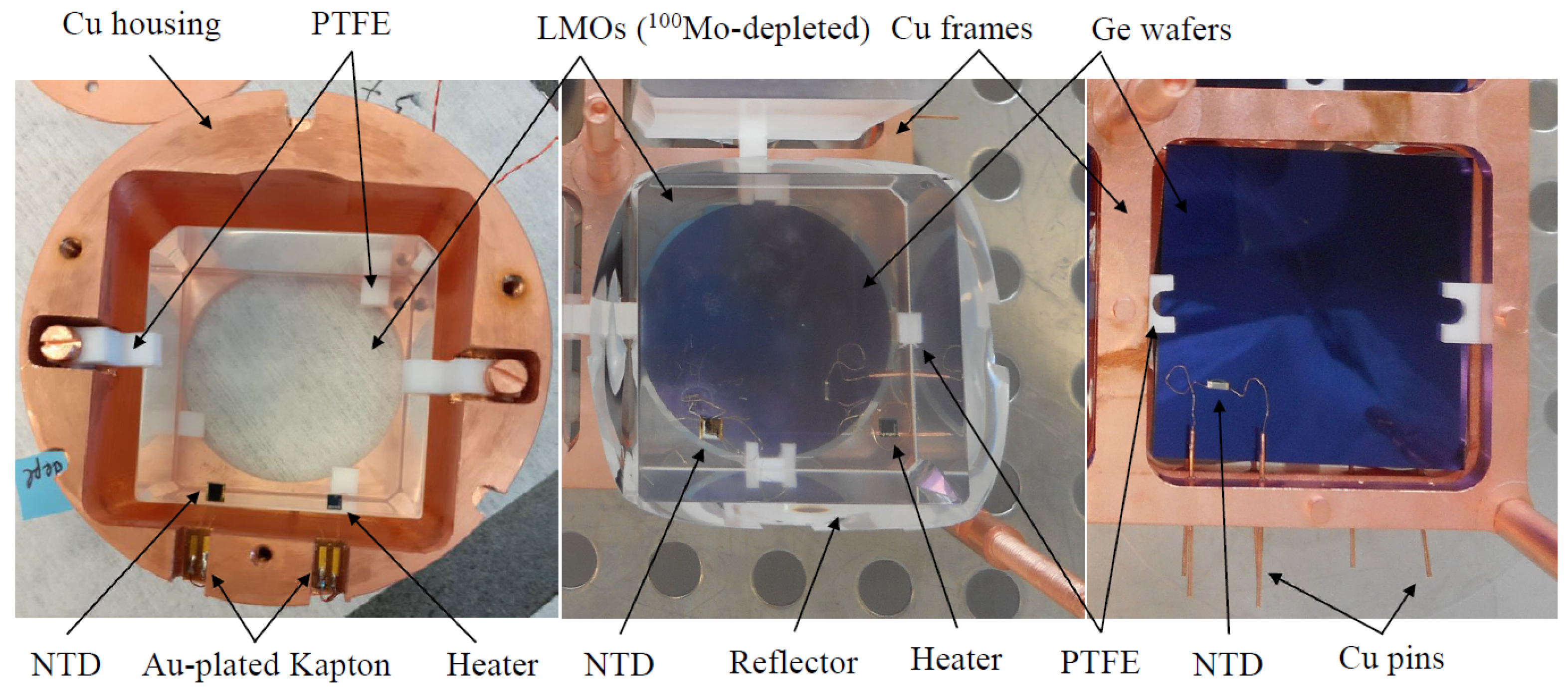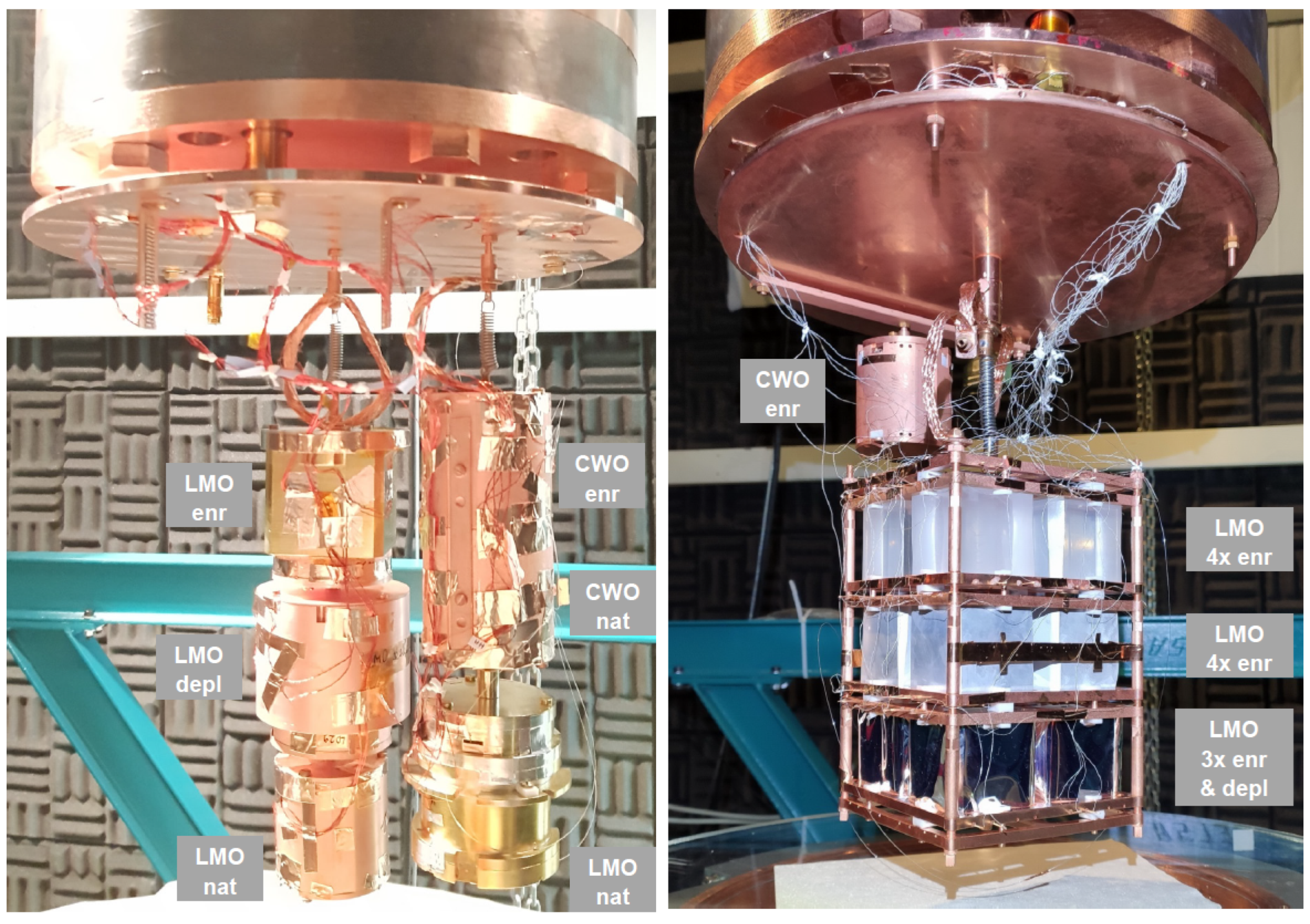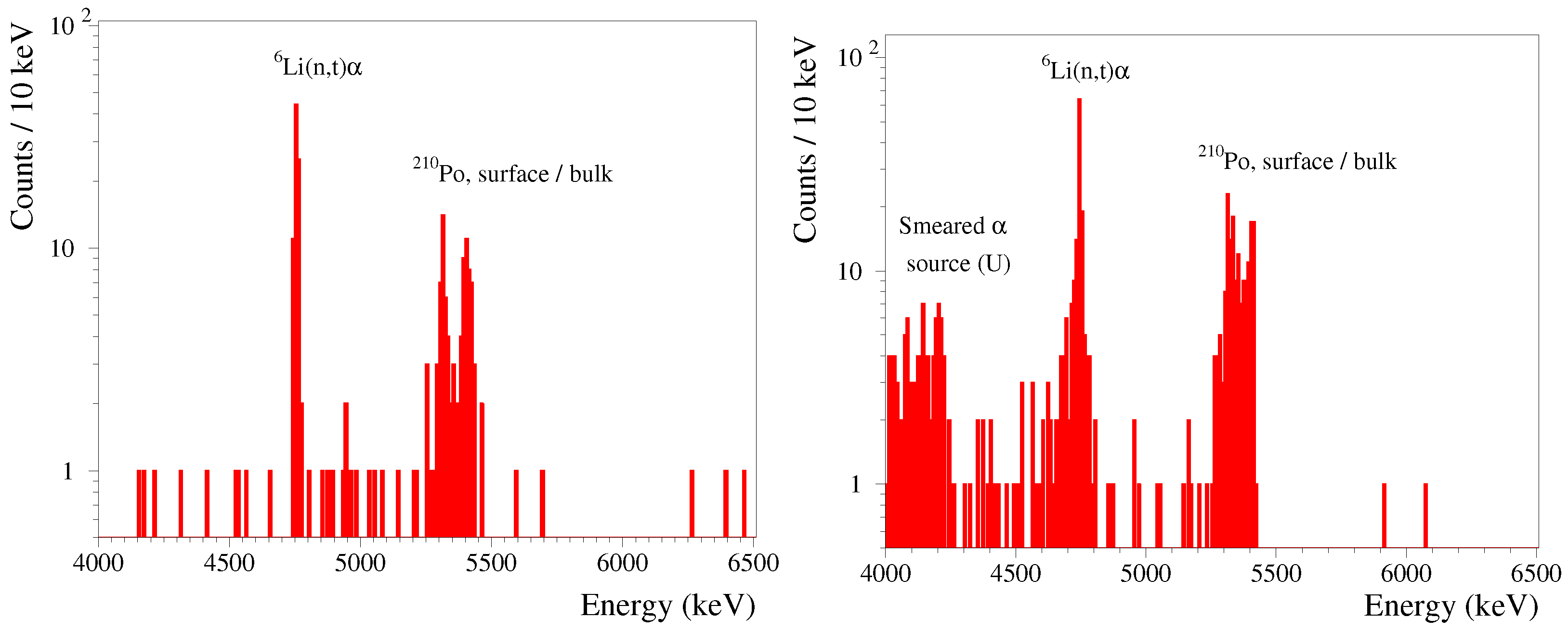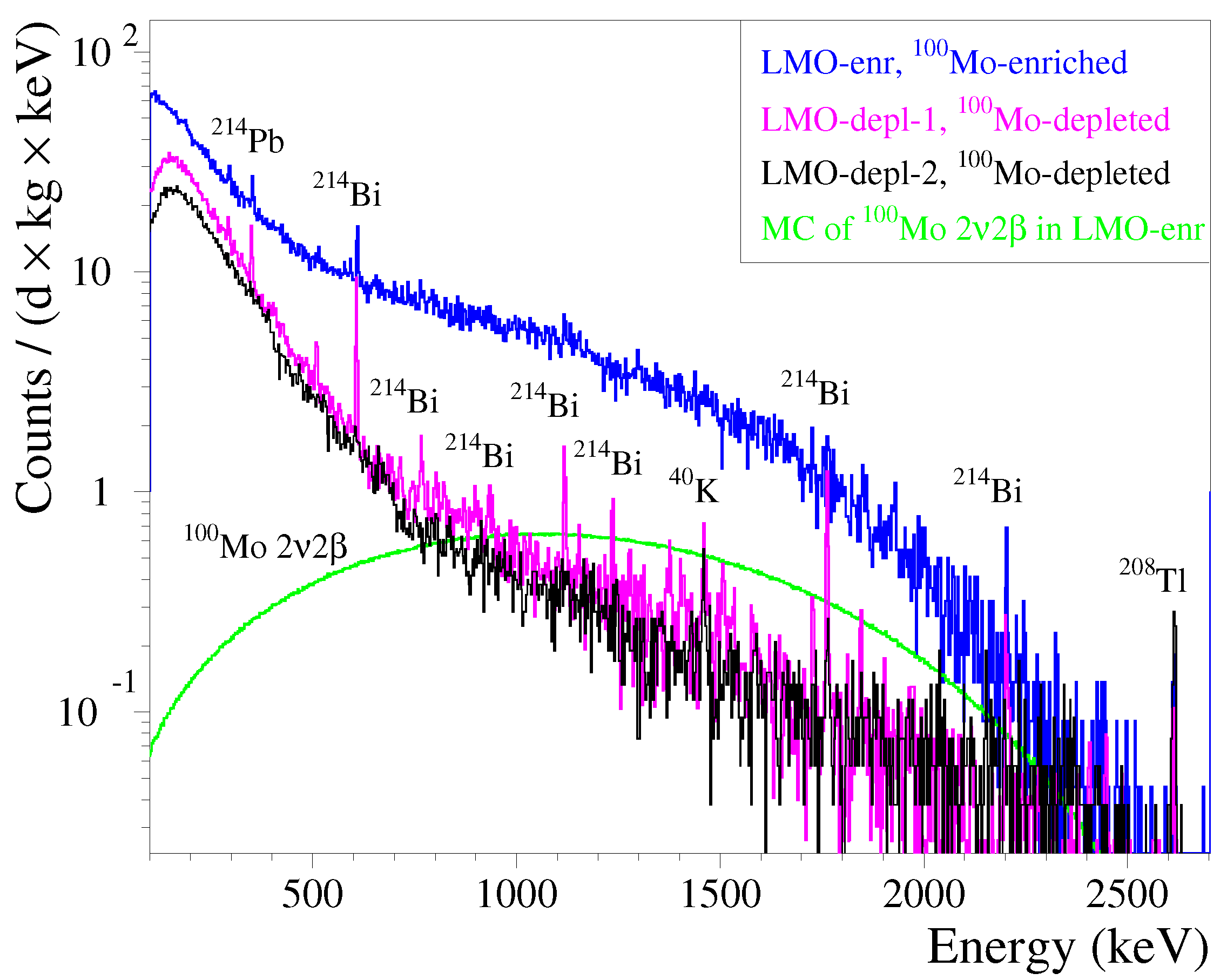Li2100deplMoO4 Scintillating Bolometers for Rare-Event Search Experiments
Abstract
1. Introduction
2. Development and Test of LiMoO Scintillating Bolometers
2.1. Crystals Production and Construction of Detectors
2.2. Operation at Canfranc Underground Laboratory
3. Characterization of LiMoO Scintillating Bolometers
3.1. Performance of Detectors
3.2. Scintillation Detection and Particle Identification
3.3. Radiopurity of LiMoO crystals
3.4. Background Reconstruction Capability of LiMoO Bolometers
4. Conclusions
Author Contributions
Funding
Institutional Review Board Statement
Informed Consent Statement
Data Availability Statement
Acknowledgments
Conflicts of Interest
References
- Pirro, S.; Mauskopf, P. Advances in Bolometer Technology for Fundamental Physics. Annu. Rev. Nucl. Part. Sci. 2017, 67, 161. [Google Scholar] [CrossRef]
- Bellini, F. Potentialities of the future technical improvements in the search of rare nuclear decays by bolometers. Int. J. Mod. Phys. A 2018, 33, 1843003. [Google Scholar] [CrossRef]
- Biassoni, M.; Cremonesi, O. Search for neutrino-less double beta decay with thermal detectors. Prog. Part. Nucl. Phys. 2020, 114, 103803. [Google Scholar] [CrossRef]
- Poda, D. Scintillation in Low-Temperature Particle Detectors. Physics 2021, 3, 473–535. [Google Scholar] [CrossRef]
- Zolotarova, A. Bolometric Double Beta Decay Experiments: Review and Prospects. Symmetry 2021, 13, 2255. [Google Scholar] [CrossRef]
- Tretyak, V.I.; Zdesenko, Y.G. Tables of double beta decay data—An update. At. Data Nucl. Data Tables 2002, 80, 83–116. [Google Scholar] [CrossRef]
- Ejiri, H.; Engel, J.; Hazama, R.; Krastev, P.; Kudomi, N.; Robertson, R. Spectroscopy of Double-Beta and Inverse-Beta Decays from 100Mo for Neutrinos. Phys. Rev. Lett. 2000, 85, 2917. [Google Scholar] [CrossRef]
- Ejiri, H.; Engel, J.; Kudomi, N. Supernova-neutrino studies with 100Mo. Phys. Lett. B 2002, 530, 27–32. [Google Scholar] [CrossRef]
- Ejiri, H.; Elliott, S.R. Charged current neutrino cross section for solar neutrinos, and background to ββ(0ν) experiments. Phys. Rev. C 2014, 89, 055501. [Google Scholar] [CrossRef]
- Ejiri, H.; Elliott, S.R. Solar neutrino interactions with the double-β decay nuclei 82Se, 100Mo, and 150Nd. Phys. Rev. C 2017, 95, 055501. [Google Scholar] [CrossRef]
- Cardani, L.; Casali, N.; Nagorny, S.; Pattavina, L.; Piperno, G.; Barinova, O.; Beeman, J.; Bellini, F.; Danevich, F.; Di Domizio, S.; et al. Development of a Li2MoO4 scintillating bolometer for low background physics. J. Instrum. 2013, 8, P10002. [Google Scholar] [CrossRef]
- Bekker, T.; Coron, N.; Danevich, F.; Degoda, V.Y.; Giuliani, A.; Grigorieva, V.; Ivannikova, N.; Mancuso, M.; De Marcillac, P.; Moroz, I.; et al. Aboveground test of an advanced Li2MoO4 scintillating bolometer to search for neutrinoless double beta decay of 100Mo. Astropart. Phys. 2016, 72, 38. [Google Scholar] [CrossRef]
- Armengaud, E.; Augier, C.; Barabash, A.; Beeman, J.; Bekker, T.; Bellini, F.; Benoît, A.; Bergé, L.; Bergmann, T.; Billard, J.; et al. Development of 100Mo-containing scintillating bolometers for a high-sensitivity neutrinoless double-beta decay search. Eur. Phys. J. C 2017, 77, 785. [Google Scholar] [CrossRef]
- Grigorieva, V.D.; Shlegel, V.; Bekker, T.; Ivannikova, N.; Giuliani, A.; de Marcillac, P.; Marnieros, S.; Novati, V.; Olivieri, E.; Poda, D.; et al. Li2MoO4 crystals grown by low thermal gradient Czochralski technique. J. Mater. Sci. Eng. B 2017, 7, 63. [Google Scholar]
- Poda, D.V.; LUMINEU, EDELWEISS, CUPID-0/Mo collaborations. 100Mo-enriched Li2MoO4 scintillating bolometers for 0ν2β decay search: From LUMINEU to CUPID-0/Mo projects. AIP Conf. Proc. 2017, 1894, 020017. [Google Scholar]
- Armengaud, E.; Augier, C.; Barabash, A.; Bellini, F.; Benato, G.; Benoît, A.; Beretta, M.; Bergé, L.; Billard, J.; Borovlev, Y.A.; et al. Precise measurement of 2νββ decay of 100Mo with the CUPID-Mo detection technology. Eur. Phys. J. C 2020, 80, 674. [Google Scholar] [CrossRef]
- Armengaud, E.; Augier, C.; Barabash, A.; Bellini, F.; Benato, G.; Benoît, A.; Beretta, M.; Bergé, L.; Billard, J.; Borovlev, Y.A.; et al. The CUPID-Mo experiment for neutrinoless double-beta decay: Performance and prospects. Eur. Phys. J. C 2020, 80, 44. [Google Scholar] [CrossRef]
- Armengaud, E.; Augier, C.; Barabash, A.; Bellini, F.; Benato, G.; Benoit, A.; Beretta, M.; Bergé, L.; Billard, J.; Borovlev, Y.A.; et al. New Limit for Neutrinoless Double-Beta Decay of 100Mo from the CUPID-Mo Experiment. Phys. Rev. Lett. 2021, 126, 181802. [Google Scholar] [CrossRef]
- Augier, C.; Barabash, A.; Bellini, F.; Benato, G.; Beretta, M.; Bergé, L.; Billard, J.; Borovlev, Y.; Cardani, L.; Casali, N.; et al. Final results on the 0νββ decay half-life limit of 100Mo from the CUPID-Mo experiment. Eur. Phys. J. C 2022, 82, 1033. [Google Scholar] [CrossRef]
- Augier, C.; Barabash, A.; Bellini, F.; Benato, G.; Beretta, M.; Bergé, L.; Billard, J.; Borovlev, Y.A.; Cardani, L.; Casali, N.; et al. New measurement of double-β decays of 100Mo to excited states of 100Ru with the CUPID-Mo experiment. Phys. Rev. C 2023, 107, 025503. [Google Scholar] [CrossRef]
- Armstrong, W.; Chang, C.; Hafidi, K.; Lisovenko, M.; Novosad, V.; Pearson, J.; Polakovic, T.; Wang, G.; Yefremenko, V.; Zhang, J.; et al. CUPID pre-CDR. arXiv 2019, arXiv:1907.09376. [Google Scholar]
- Armatol, A.; Armengaud, E.; Armstrong, W.; Augier, C.; Avignone, F.; Azzolini, O.; Barabash, A.; Bari, G.; Barresi, A.; Baudin, D.; et al. Characterization of cubic Li2100MoO4 crystals for the CUPID experiment. Eur. Phys. J. C 2021, 81, 104. [Google Scholar] [CrossRef]
- Armatol, A.; Armengaud, E.; Armstrong, W.; Augier, C.; Avignone III, F.; Azzolini, O.; Bandac, I.; Barabash, A.; Bari, G.; Barresi, A.; et al. A CUPID Li2100MoO4 scintillating bolometer tested in the CROSS underground facility. J. Instrum. 2021, 16, P02037. [Google Scholar] [CrossRef]
- Alfonso, K.; Armatol, A.; Augier, C.; Avignone III, F.; Azzolini, O.; Balata, M.; Barabash, A.; Bari, G.; Barresi, A.; Baudin, D.; et al. Optimization of the first CUPID detector module. Eur. Phys. J. C 2022, 82, 810. [Google Scholar]
- Alfonso, K.; Armatol, A.; Augier, C.; Avignone III, F.; Azzolini, O.; Balata, M.; Bandac, I.; Barabash, A.; Bari, G.; Barresi, A.; et al. Twelve-crystal prototype of Li2MoO4 scintillating bolometers for CUPID and CROSS experiments. arXiv 2023, arXiv:2304.04611. [Google Scholar]
- Bandac, I.; Barabash, A.; Bergé, L.; Brière, M.; Bourgeois, C.; Carniti, P.; Chapellier, M.; de Combarieu, M.; Dafinei, I.; Danevich, F.; et al. The 0ν2β-decay CROSS experiment: Preliminary results and prospects. J. High Energy Phys. 2020, 01, 018. [Google Scholar] [CrossRef]
- Bandac, I.; Barabash, A.; Bergé, L.; Bourgeois, C.; Calvo-Mozota, J.; Carniti, P.; Chapellier, M.; deCombarieu, M.; Dafinei, I.; Danevich, F.; et al. Phonon-mediated crystal detectors with metallic film coating capable of rejecting α and β events induced by surface radioactivity. Appl. Phys. Lett. 2021, 118, 184105. [Google Scholar] [CrossRef]
- Alenkov, V.; Aryal, P.; Beyer, J.; Boiko, R.; Boonin, K.; Buzanov, O.; Chanthima, N.; Chernyak, M.; Choi, J.; Choi, S.; et al. Technical Design Report for the AMoRE 0νββ Decay Search Experiment. arXiv 2015, arXiv:1512.05957. [Google Scholar]
- Kim, H.; Jeon, J.; Kim, I.; Kim, S.; Kim, H.; Kim, Y.; Kwon, D.; Lee, M.; So, J. Compact phonon-scintillation detection system for rare event searches at low temperatures. Nucl. Instrum. Methods Phys. Res. A 2020, 954, 162107. [Google Scholar] [CrossRef]
- Kim, H.; Kim, H.; Kim, I.; Kim, S.R.; Kim, Y.; Kim, Y.H.; Kwon, D.; Jeon, J.A.; Lee, M.H.; Lee, M.; et al. Li2MoO4 Phonon–Scintillation Detection Systems with MMC Readout. J. Low Temp. Phys. 2020, 199, 1082. [Google Scholar] [CrossRef]
- Kim, W.; Kim, S.; Sharma, B.; Jeon, J.; Kim, H.; Kim, S.; Kim, S.; Kim, Y.; Kim, Y.; Lee, H.; et al. Test Measurements of an MMC-Based 516-g Lithium Molybdate Crystal Detector for the AMoRE-II Experiment. J. Low Temp. Phys. 2022, 209, 299–307. [Google Scholar] [CrossRef]
- Kim, H.; Ha, D.; Jeon, E.; Jeon, J.; Jo, H.; Kang, C.; Kang, W.; Kim, H.; Kim, S.; Kim, S.; et al. Status and Performance of the AMoRE-I Experiment on Neutrinoless Double Beta Decay. J. Low Temp. Phys. 2022, 209, 962–970. [Google Scholar] [CrossRef]
- Bednyakov, V.A.; Šimkovic, F. Nuclear Spin Structure in Dark Matter Search: The Finite Momentum Transfer Limit. Phys. Part. Nucl. 2005, 37, S106–S128. [Google Scholar] [CrossRef]
- Abdelhameed, A.; Angloher, G.; Bauer, P.; Bento, A.; Bertoldo, E.; Bucci, C.; Canonica, L.; D’Addabbo, A.; Defay, X.; Di Lorenzo, S.; et al. First results on sub-GeV spin-dependent dark matter interactions with 7Li. Eur. Phys. J. C 2019, 79, 630. [Google Scholar] [CrossRef]
- Krčmar, M.; Krečak, Z.; Ljubičič, A.; Stipčević, M.; Bradley, D.A. Search for solar axions using 7Li. Phys. Rev. D 2001, 64, 115016. [Google Scholar] [CrossRef]
- Belli, P.; Bernabei, R.; Cerulli, R.; Danevich, F.; d’Angelo, A.; Goriletsky, V.; Grinyov, B.; Incicchitti, A.; Kobychev, V.; Laubenstein, M.; et al. 7Li solar axions: Preliminary results and feasibility studies. Nucl. Phys. A 2008, 806, 388–397. [Google Scholar] [CrossRef]
- Barinova, O.; Danevich, F.; Degoda, V.Y.; Kirsanova, S.; Kudovbenko, V.; Pirro, S.; Tretyak, V. First test of Li2MoO4 crystal as a cryogenic scintillating bolometer. Nucl. Instrum. Methods Phys. Res. A 2010, 613, 54–57. [Google Scholar] [CrossRef]
- Belli, P.; Bernabei, R.; Cappella, F.; Cerulli, R.; Danevich, F.; Incicchitti, A.; Kobychev, V.; Laubenstein, M.; Polischuk, O.; Tretyak, V.; et al. Search for 7Li solar axions using resonant absorption in LiF crystal: Final results. Phys. Lett. B 2012, 711, 41–45. [Google Scholar] [CrossRef]
- Martínez, M.; Coron, N.; Ginestra, C.; Gironnet, J.; Gressier, V.; Leblanc, J.; de Marcillac, P.; Redon, T.; Di Stefano, P.; Torres, L.; et al. Scintillating bolometers for fast neutron spectroscopy in rare events searches. J. Phys. Conf. Ser. 2012, 375, 012025. [Google Scholar] [CrossRef]
- Coron, N.; Cuesta, C.; García, E.; Ginestra, C.; Gironnet, J.; de Marcillac, P.; Martínez, M.; Ortigoza, Y.; de Solórzano, A.O.; Puimedón, J.; et al. Neutron Spectrometry With Scintillating Bolometers of LiF and Sapphire. IEEE Trans. Nucl. Sci. 2016, 63, 1967–1975. [Google Scholar] [CrossRef]
- Barabash, A.S. Precise Half-Life Values for Two-Neutrino Double-β Decay: 2020 Review. Universe 2020, 6, 159. [Google Scholar] [CrossRef]
- Grigorieva, V.D.; Shlegel, V.; Borovlev, Y.; Bekker, T.; Barabash, A.; Konovalov, S.; Umatov, V.; Borovkov, V.; Meshkov, O. Li2100deplMoO4 crystals grown by low-thermal-gradient Czochralski technique. J. Cryst. Growth 2020, 552, 125913. [Google Scholar] [CrossRef]
- Bergé, L.; Boiko, R.; Chapellier, M.; Chernyak, D.; Coron, N.; Danevich, F.; Decourt, R.; Degoda, V.Y.; Devoyon, L.; Drillien, A.; et al. Purification of molybdenum, growth and characterization of medium volume ZnMoO4 crystals for the LUMINEU program. J. Instrum. 2014, 9, P06004. [Google Scholar] [CrossRef]
- Bergé, L.; Chapellier, M.; De Combarieu, M.; Dumoulin, L.; Giuliani, A.; Gros, M.; De Marcillac, P.; Marnieros, S.; Nones, C.; Novati, V.; et al. Complete event-by-event α/γ(β) separation in a full-size TeO2 CUORE bolometer by Neganov-Luke-magnified light detection. Phys. Rev. C 2018, 97, 032501. [Google Scholar] [CrossRef]
- Haller, E.E. Advanced far-infrared detectors. Infrared Phys. Technol. 1994, 35, 127. [Google Scholar] [CrossRef]
- Andreotti, E.; Brofferio, C.; Foggetta, L.; Giuliani, A.; Margesin, B.; Nones, C.; Pedretti, M.; Rusconi, C.; Salvioni, C.; Tenconi, M. Production, characterization and selection of the heating elements for the response stabilization of the CUORE bolometers. Nucl. Instrum. Methods Phys. Res. Sect. A 2012, 664, 161. [Google Scholar] [CrossRef]
- Alessandrello, A.; Brofferio, C.; Bucci, C.; Cremonesi, O.; Giuliani, A.; Margesin, B.; Nucciotti, A.; Pavan, M.; Pessina, G.; Previtali, E.; et al. Methods for response stabilization in bolometers for rare decays. J. Cryst. Growth 1998, 412, 454. [Google Scholar] [CrossRef]
- Azzolini, O.; Barrera, M.; Beeman, J.; Bellini, F.; Beretta, M.; Biassoni, M.; Brofferio, C.; Bucci, C.; Canonica, L.; Capelli, S.; et al. CUPID-0: The first array of enriched scintillating bolometers for 0νββ decay investigations. Eur. Phys. J. C 2018, 78, 428. [Google Scholar] [CrossRef]
- Armatol, A.; Armengaud, E.; Armstrong, W.; Augier, C.; Avignone III, F.; Azzolini, O.; Barabash, A.; Bari, G.; Barresi, A.; Baudin, D.; et al. Novel technique for the study of pileup events in cryogenic bolometers. Phys. Rev. C 2021, 104, 015501. [Google Scholar] [CrossRef]
- Umicore Germanium Substrates. Available online: https://eom.umicore.com/en/germanium-solutions/products/germanium-substrates/ (accessed on 25 April 2023).
- Mancuso, M.; Beeman, J.; Giuliani, A.; Dumoulin, L.; Olivieri, E.; Pessina, G.; Plantevin, O.; Rusconi, C.; Tenconi, M. An experimental study of antireflective coatings in Ge light detectors for scintillating bolometers. EPJ Web Conf. 2014, 65, 04003. [Google Scholar] [CrossRef]
- Olivieri, E. CROSS Collaboration. The new CROSS Cryogenic Underground (C2U) facility: An overview. In Proceedings of the XXIX International (online) Conference on Neutrino Physics and Astrophysics (Neutrino 2020), Chicago, IL, USA, 22 June–2 July 2020. [Google Scholar]
- Trzaska, W.H.; Slupecki, M.; Bandac, I.; Bayo, A.; Bettini, A.; Bezrukov, L.; Enqvist, T.; Fazliakhmetov, A.; Ianni, A.; Inzhechik, L.; et al. Cosmic-ray muon flux at Canfranc Underground Laboratory. Eur. Phys. J. C 2019, 79, 721. [Google Scholar] [CrossRef]
- The Ultra-Quiet Technology. Available online: https://cryoconcept.com/product/the-ultra-quiet-technology/ (accessed on 25 April 2023).
- Olivieri, E.; Billard, J.; De Jesus, M.; Juillard, A.; Leder, A. Vibrations on pulse tube based Dry Dilution Refrigerators for low noise measurements. Nucl. Instrum. Methods Phys. Res. Sect. A 2017, 858, 73. [Google Scholar] [CrossRef]
- Pérez-Pérez, J.; Amare, J.C.; Bandac, I.C.; Bayo, A.; Borjabad-Sánchez, S.; Calvo-Mozota, J.M.; Cid-Barrio, L.; Hernández-Antolín, R.; Hernández-Molinero, B.; Novella, P.; et al. Radon Mitigation Applications at the Laboratorio Subterráneo de Canfranc (LSC). Universe 2022, 8, 112. [Google Scholar] [CrossRef]
- Khalife, H. CROSS and CUPID-Mo: Future Strategies and New Results in Bolometric Search for 0νββ. Ph.D. Thesis, Université Paris-Saclay, Orsay, France, 2021. [Google Scholar]
- Velázquez, M.; Veber, P.; Moutatouia, M.; De Marcillac, P.; Giuliani, A.; Loaiza, P.; Denux, D.; Decourt, R.; El Hafid, H.; Laubenstein, M.; et al. Exploratory growth in the Li2MoO4-MoO3 system for the next crystal generation of heat-scintillation cryogenic bolometers. Solid State Sci. 2017, 65, 41. [Google Scholar] [CrossRef]
- Stelian, C.; Velazquez, M.; Veber, P.; Ahmine, A.; Duffar, T.; de Marcillac, P.; Giuliani, A.; Poda, D.; Marnieros, S.; Nones, C.; et al. Experimental and numerical investigations of the Czochralski growth of Li2MoO4 crystals for heat-scintillation cryogenic bolometers. J. Cryst. Growth 2020, 531, 125385. [Google Scholar] [CrossRef]
- Zolotarova, A.; CROSS collaboration. The CROSS experiment: Search for 0ν2β decay with surface sensitive bolometers. J. Phys. Conf. Ser. 2020, 1468, 012147. [Google Scholar] [CrossRef]
- Helis, D.L.; Bandac, I.; Barabash, A.; Billard, J.; Chapellier, M.; de Combarieu, M.; Danevich, F.; Dumoulin, L.; Gascon, J.; Giuliani, A.; et al. Neutrinoless double-beta decay searches with enriched 116CdWO4 scintillating bolometers. J. Low Temp. Phys. 2020, 199, 467. [Google Scholar] [CrossRef]
- Helis, D. Searching for Neutrinoless Double-Beta Decay with Scintillating Bolometers. Ph.D. Thesis, Université Paris-Saclay, Orsay, France, 2021. [Google Scholar]
- Arnaboldi, C.; Bucci, C.; Campbell, J.; Capelli, S.; Nucciotti, A.; Pavan, M.; Pessina, G.; Pirro, S.; Previtali, E.; Rosenfeld, C.; et al. The programmable front-end system for CUORICINO, an array of large-mass bolometers. IEEE Trans. Nucl. Sci. 2002, 49, 2440–2447. [Google Scholar] [CrossRef]
- Carniti, P.; Gotti, C.; Pessina, G. High-Resolution Digitization System for the CROSS Experiment. J. Low Temp. Phys. 2020, 199, 833. [Google Scholar] [CrossRef]
- Carniti, P.; Gotti, C.; Pessina, G. High resolution filtering and digitization system for cryogenic bolometric detectors. Nucl. Instrum. Methods Phys. Res. Sect. A 2023, 1045, 167658. [Google Scholar] [CrossRef]
- Novati, V.; Bergé, L.; Dumoulin, L.; Giuliani, A.; Mancuso, M.; de Marcillac, P.; Marnieros, S.; Olivieri, E.; Poda, D.; Tenconi, M.; et al. Charge-to-heat transducers exploiting the Neganov-Trofimov-Luke effect for light detection in rare-event searches. Nucl. Instrum. Methods Phys. Res. A 2019, 940, 320–327. [Google Scholar] [CrossRef]
- Mancuso, M. Development and Optimization of Scintillating Bolometers and Innovative Light Detectors for the Search for Neutrinoless Double Beta Decay. Ph.D. Thesis, Université Paris-Sud, Orsay, France, 2016. [Google Scholar]
- Gatti, E.; Manfredi, P. Processing the signals from solid-state detectors in elementary-particle physics. Riv. Nuovo Cim. 1986, 9, 1. [Google Scholar] [CrossRef]
- Beeman, J.; Bellini, F.; Casali, N.; Cardani, L.; Dafinei, I.; Di Domizio, S.; Ferroni, F.; Gironi, L.; Nagorny, S.; Orio, F.; et al. Characterization of bolometric Light Detectors for rare event searches. J. Instrum. 2013, 8, P07021. [Google Scholar] [CrossRef]
- Pirro, S.; Beeman, J.; Capelli, S.; Pavan, M.; Previtali, E.; Gorla, P. Scintillating double beta decay bolometers. Phys. Atom. Nucl. 2006, 69, 2109. [Google Scholar] [CrossRef]
- Piperno, G.; Pirro, S.; Vignati, M. Optimizing the energy threshold of light detectors coupled to luminescent bolometers. J. Instrum. 2011, 6, P10005. [Google Scholar] [CrossRef]
- Poda, D.V.; CUPID-Mo Collaboration. Performance of the CUPID-Mo double-beta decay bolometric experiment. In Proceedings of the XXIX International (online) Conference on Neutrino Physics and Astrophysics (Neutrino 2020), Chicago, IL, USA, 22 June–2 July 2020. [Google Scholar]
- Armengaud, E.; Arnaud, Q.; Augier, C.; Benoit, A.; Berge, L.; Boiko, R.S.; Bergmann, T.; Blümer, J.; Broniatowski, A.; Brudanin, V.; et al. Development and underground test of radiopure ZnMoO4 scintillating bolometers for the LUMINEU 0ν2β project. J. Instrum. 2015, 10, P05007. [Google Scholar] [CrossRef]
- Danevich, F.A. Radiopure tungstate and molybdate crystal scintillators for double beta decay experiments. Int. J. Mod. Phys. A 2017, 32, 1743008. [Google Scholar] [CrossRef]
- Danevich, F.A.; Tretyak, V.I. Radioactive contamination of scintillators. Int. J. Mod. Phys. A 2018, 33, 1843007. [Google Scholar] [CrossRef]
- Feldman, G.J.; Cousins, R.D. Unified approach to the classical statistical analysis of small signals. Phys. Rev. D 1998, 3873, 57. [Google Scholar] [CrossRef]
- Augier, C.; Barabash, A.; Bellini, F.; Benato, G.; Beretta, M.; Bergé, L.; Billard, J.; Borovlev, Y.; Cardani, L.; Casali, N.; et al. The background model of the CUPID-Mo 0νββ experiment. Eur. Phys. J. C 2023. to be submitted. [Google Scholar]
- Azzolini, O.; Beeman, J.; Bellini, F.; Beretta, M.; Biassoni, M.; Brofferio, C.; Bucci, C.; Capelli, S.; Cardani, L.; Carniti, P.; et al. Background model of the CUPID-0 experiment. Eur. Phys. J. C 2019, 79, 583. [Google Scholar] [CrossRef]
- Azzolini, O.; Beeman, J.; Bellini, F.; Beretta, M.; Biassoni, M.; Brofferio, C.; Bucci, C.; Capelli, S.; Caracciolo, V.; Cardani, L.; et al. Final Result on the Neutrinoless Double Beta Decay of 82Se with CUPID-0. Phys. Rev. Lett. 2022, 129, 111801. [Google Scholar] [CrossRef] [PubMed]
- Adams, D.; Alduino, C.; Alfonso, K.; Avignone, F., III; Azzolini, O.; Bari, G.; Bellini, F.; Benato, G.; Biassoni, M.; Branca, A.; et al. Measurement of the 2νββ Decay Half-Life of 130Te with CUORE. Phys. Rev. Lett. 2021, 126, 171801. [Google Scholar] [CrossRef] [PubMed]
- Adams, D.; Alduino, C.; Alfonso, K.; Avignone, F., III; Azzolini, O.; Bari, G.; Bellini, F.; Benato, G.; Beretta, M.; Biassoni, M.; et al. Search for Majorana neutrinos exploiting millikelvin cryogenics with CUORE. Nature 2022, 604, 53. [Google Scholar]
- der Mateosian, E.; Goldhaber, M. Limits for Lepton-Conserving and Lepton-Nonconserving Double Beta Decay in Ca48. Phys. Rev. 1966, 146, 810–815. [Google Scholar] [CrossRef]
- Gavrilyuk, Y.M.; Gangapshev, A.M.; Kazalov, V.V.; Kuzminov, V.V.; Panasenko, S.I.; Ratkevich, S.S. Indications of 2ν2K capture in 78Kr. Phys. Rev. C 2013, 87, 035501. [Google Scholar] [CrossRef]
- Novella, P.; Sorel, M.; Usón, A.; Adams, C.; Almazán, H.; Álvarez, V.; Aparicio, B.; Aranburu, A.; Arazi, L.; Arnquist, I.; et al. Measurement of the 136Xe two-neutrino double-β-decay half-life via direct background subtraction in NEXT. Phys. Rev. C 2022, 105, 055501. [Google Scholar] [CrossRef]
- Giuliani, A.; Poves, A. Neutrinoless Double-Beta Decay. Adv. High Energy Phys. 2012, 2012, 857016. [Google Scholar] [CrossRef]







| Bolometer | Temperature | Resistance | Rise | Decay | Sensitivity | FWHMNoise | FWHM (keV) |
|---|---|---|---|---|---|---|---|
| of NTD | Time | Time | (nV/keV) | (keV) | at Energy (keV) | ||
| (mK) | (MΩ) | (ms) | (ms) | ||||
| LMO-depl-1 | 18 | 2.4 | 16 | 112 | 17 | 3.66 (3) | 5.9 (10) at 1765 |
| 12 | 6.5 | 20 | 115 | 37 | 2.18 (3) | 5.8 (3) at 2615 | |
| LMO-depl-2 | 14 | 3.0 | 16 | 97 | 29 | 3.80 (3) | 6.8 (3) at 2615 |
| LD-1-c | 18 | 1.6 | 1.5 | 9.0 | 1200 | 0.097 (1) | 0.174 (4) at 5.9 |
| 12 | 2.6 | 1.6 | 10.5 | 1380 | 0.100 (1) | 0.146 (2) at 5.9 | |
| LD-2-s | 14 | 0.47 | 1.6 | 5.2 | 380 | 0.343 (5) | 0.94 (6) at 17.5 |
| LD-2-c | 14 | 4.4 | 2.0 | 7.8 | 2200 | 0.059 (1) | 0.90 (6) at 17.5 |
| Crystal | Photodetector | (keV/MeV) | |
|---|---|---|---|
| LMO-depl-1 | LD-1-c | 0.33 (3) | 0.21 (4) |
| LMO-depl-2 | LD-2-c | 0.44 (3) | 0.19 (4) |
| LD-2-s | 0.59 (9) |
| Crystal | Activity (µBq/kg) | |||||
|---|---|---|---|---|---|---|
| Th | Th | U | U | Ra | Po | |
| [4082] | [5520] | [4270] | [4858] | [4871] | [5407] | |
| LMO-depl-1 | <2 | <2 | <2 | <5 | <7 | 35 (6) |
| LMO-depl-2 | <2 | <4 | 36 (5) | |||
Disclaimer/Publisher’s Note: The statements, opinions and data contained in all publications are solely those of the individual author(s) and contributor(s) and not of MDPI and/or the editor(s). MDPI and/or the editor(s) disclaim responsibility for any injury to people or property resulting from any ideas, methods, instructions or products referred to in the content. |
© 2023 by the authors. Licensee MDPI, Basel, Switzerland. This article is an open access article distributed under the terms and conditions of the Creative Commons Attribution (CC BY) license (https://creativecommons.org/licenses/by/4.0/).
Share and Cite
Bandac, I.C.; Barabash, A.S.; Bergé, L.; Borovlev, Y.A.; Calvo-Mozota, J.M.; Carniti, P.; Chapellier, M.; Dafinei, I.; Danevich, F.A.; Dumoulin, L.; et al. Li2100deplMoO4 Scintillating Bolometers for Rare-Event Search Experiments. Sensors 2023, 23, 5465. https://doi.org/10.3390/s23125465
Bandac IC, Barabash AS, Bergé L, Borovlev YA, Calvo-Mozota JM, Carniti P, Chapellier M, Dafinei I, Danevich FA, Dumoulin L, et al. Li2100deplMoO4 Scintillating Bolometers for Rare-Event Search Experiments. Sensors. 2023; 23(12):5465. https://doi.org/10.3390/s23125465
Chicago/Turabian StyleBandac, Iulian C., Alexander S. Barabash, Laurent Bergé, Yury A. Borovlev, José Maria Calvo-Mozota, Paolo Carniti, Maurice Chapellier, Ioan Dafinei, Fedor A. Danevich, Louis Dumoulin, and et al. 2023. "Li2100deplMoO4 Scintillating Bolometers for Rare-Event Search Experiments" Sensors 23, no. 12: 5465. https://doi.org/10.3390/s23125465
APA StyleBandac, I. C., Barabash, A. S., Bergé, L., Borovlev, Y. A., Calvo-Mozota, J. M., Carniti, P., Chapellier, M., Dafinei, I., Danevich, F. A., Dumoulin, L., Ferri, F., Giuliani, A., Gotti, C., Gras, P., Grigorieva, V. D., Ianni, A., Khalife, H., Kobychev, V. V., Konovalov, S. I., ... Zolotarova, A. (2023). Li2100deplMoO4 Scintillating Bolometers for Rare-Event Search Experiments. Sensors, 23(12), 5465. https://doi.org/10.3390/s23125465







